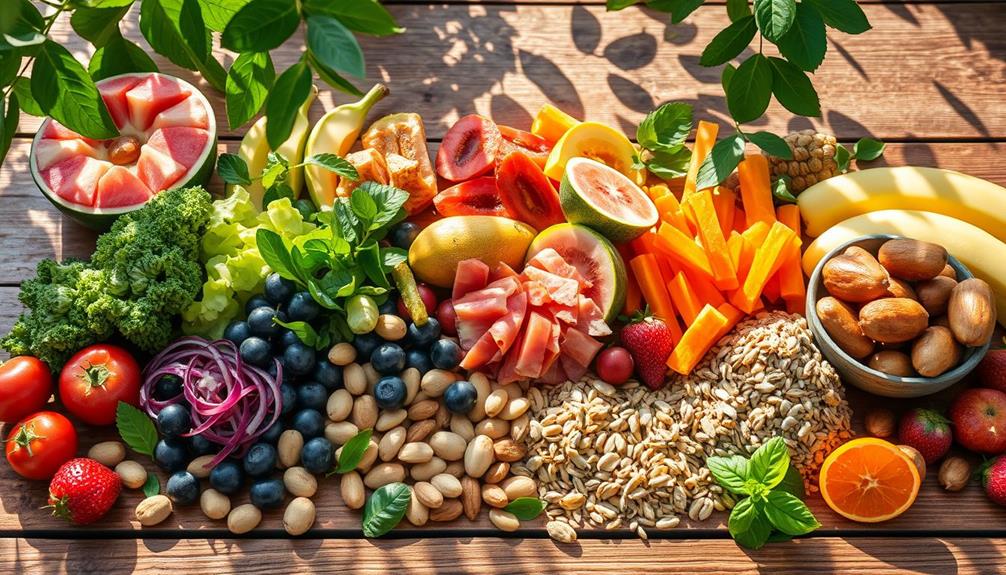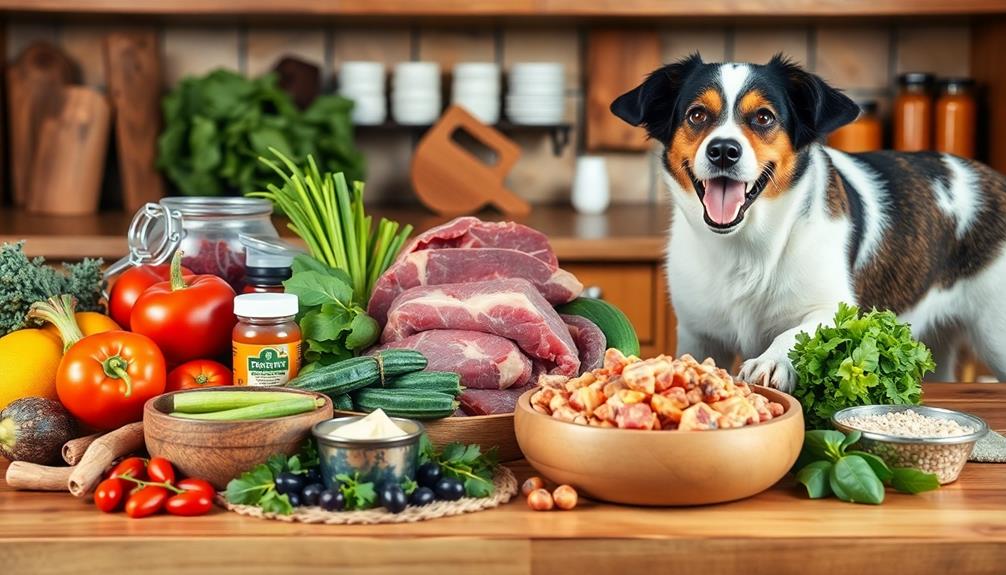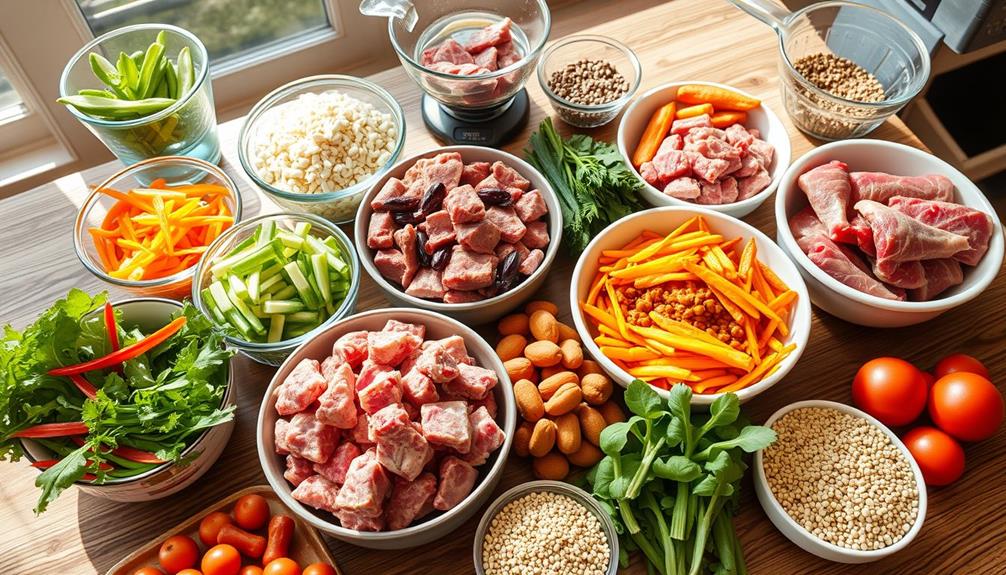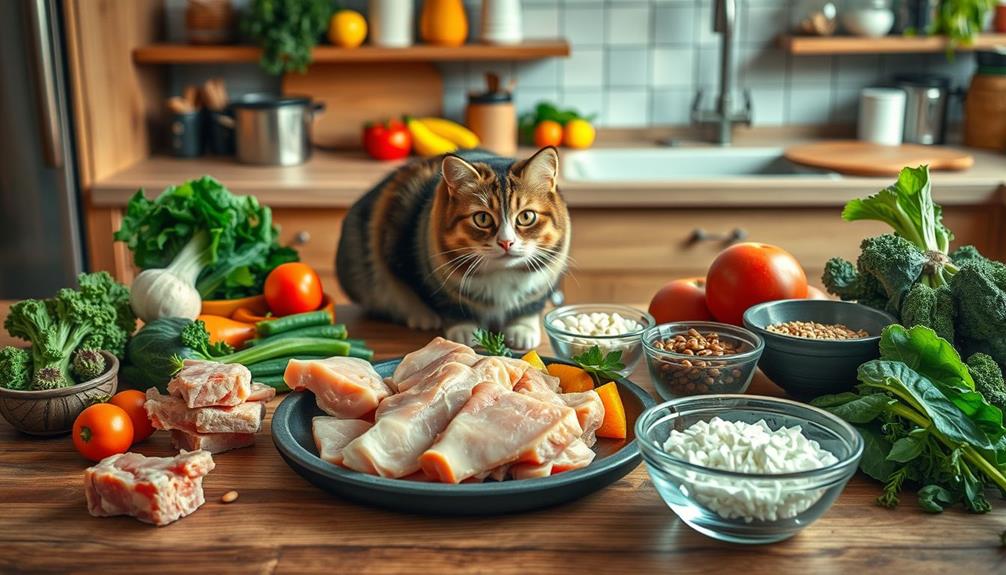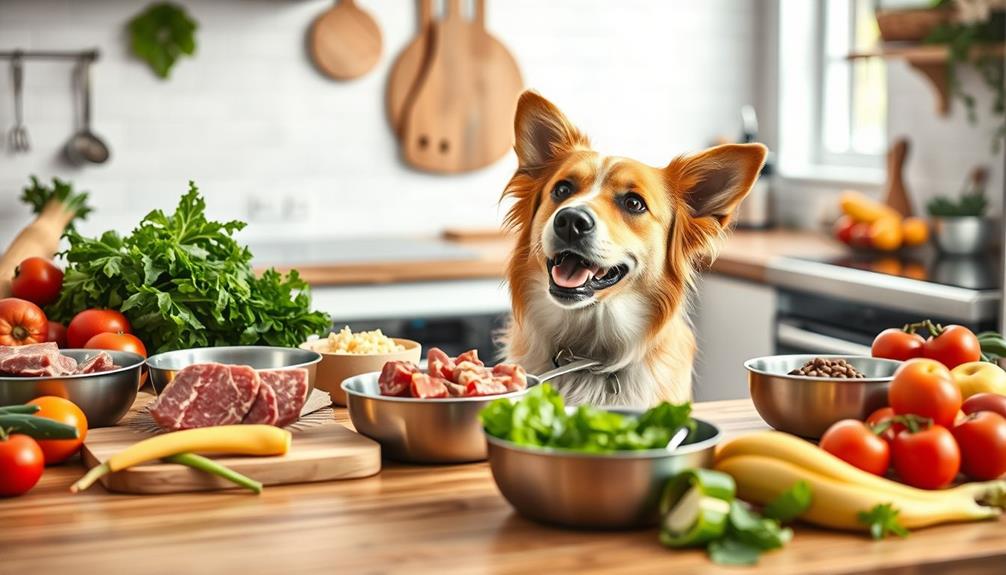Raw foods are uncooked items that you consume without heating above 48°C (115°F). This includes fresh fruits, vegetables, nuts, seeds, and some raw dairy products. The appeal lies in preserving their natural nutrients and enzymes. Following a raw diet can boost your digestion and overall health, but it isn't without challenges. You might face nutritional gaps and a higher risk of foodborne illnesses if you're not careful. It's crucial to be mindful about your meal planning and preparation. Explore the benefits and risks further to make informed choices about this vibrant lifestyle.
Key Takeaways
- Raw foods are uncooked items not heated above 48°C (115°F), including fruits, vegetables, nuts, seeds, and some dairy products.
- The raw food diet aims to preserve natural enzymes and nutrients for enhanced health benefits and overall wellness.
- Potential health benefits include improved digestion, better skin health, weight loss, and reduced chronic disease risks.
- Risks of raw food consumption include foodborne illnesses and nutritional deficiencies, particularly in protein, vitamin B12, and iron.
- Proper food preparation techniques, such as soaking and sprouting, are essential for maximizing nutrient absorption and ensuring food safety.
Definition of Raw Foods
Raw foods are defined as uncooked items that haven't been heated above 48°C (115°F), which helps preserve their natural enzymes and nutrients. This culinary approach primarily includes fresh fruits and vegetables, nuts, seeds, and some dairy products, while excluding refined or chemically processed items. By consuming these uncooked foods, you aim to maintain the nutritional integrity of the ingredients, allowing you to enjoy their full health benefits.
Advocates of the raw food diet believe that the preservation of natural enzymes in foods can enhance digestion and overall wellness. Additionally, incorporating antioxidant-rich items such as cranberry juice can complement a raw food diet, contributing to overall health.
However, it's important to be aware of the risks associated with raw food consumption, particularly the potential for foodborne illnesses like salmonella and E. coli. These risks are especially prevalent with raw produce and unpasteurized dairy products, which can pose health threats if not handled properly.
Balancing the desire for nutritious raw foods with safety precautions is significant. By understanding the benefits and risks, you can make informed choices that support your health while minimizing the chances of foodborne illness.
Embracing this diet can lead to improved well-being, provided you take care to select and prepare your foods wisely.
Growth of the Raw Food Movement
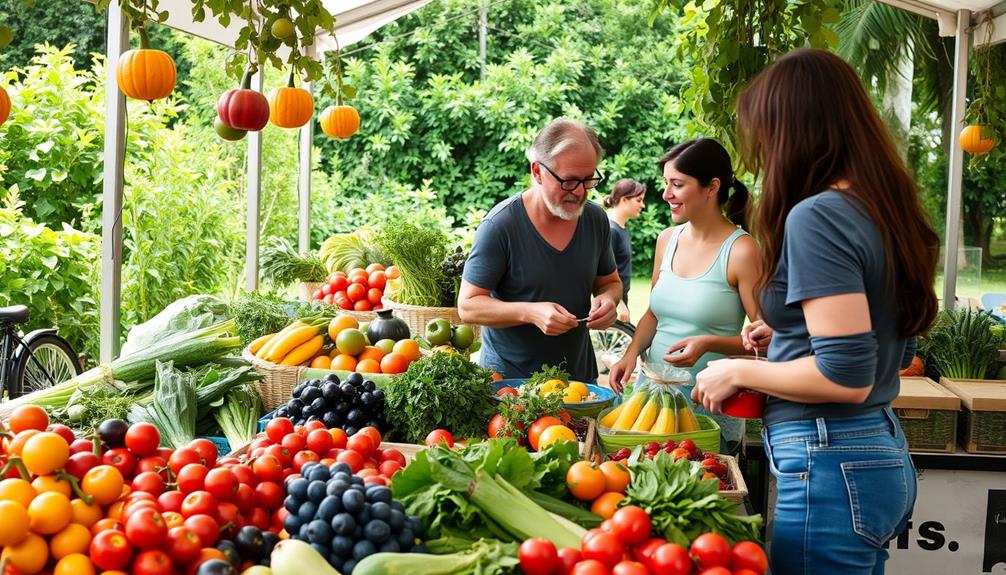
Interest in the raw food movement has surged in recent years, fueled by a growing awareness of health and wellness. Many people are now enthusiastic to adopt raw food diets, which emphasize unprocessed foods and fresh ingredients. This trend aligns with the rising popularity of natural remedies, as many individuals seek to incorporate healthier options into their lifestyles; for instance, natural remedies alongside conventional medications have gained traction in the health community.
Social media platforms have played a significant role in this shift, with influencers sharing enticing recipes and inspiring success stories that draw in a larger audience. As raw food products become more available in supermarkets and specialty stores, it's easier than ever for you to incorporate these foods into your daily meals.
However, while there are potential health benefits associated with raw diets, it's crucial to reflect on the risks involved. Ongoing debates highlight concerns regarding food safety and nutrient intake. A strict raw food lifestyle could lead to nutrient deficiencies, particularly if you're not careful in balancing your meals.
Moreover, the risk of foodborne illnesses increases when consuming raw foods, making food safety a critical aspect to address. Before diving into the raw food movement, weigh both the advantages and potential drawbacks to guarantee you make informed choices for your health and well-being.
Benefits of Cooking
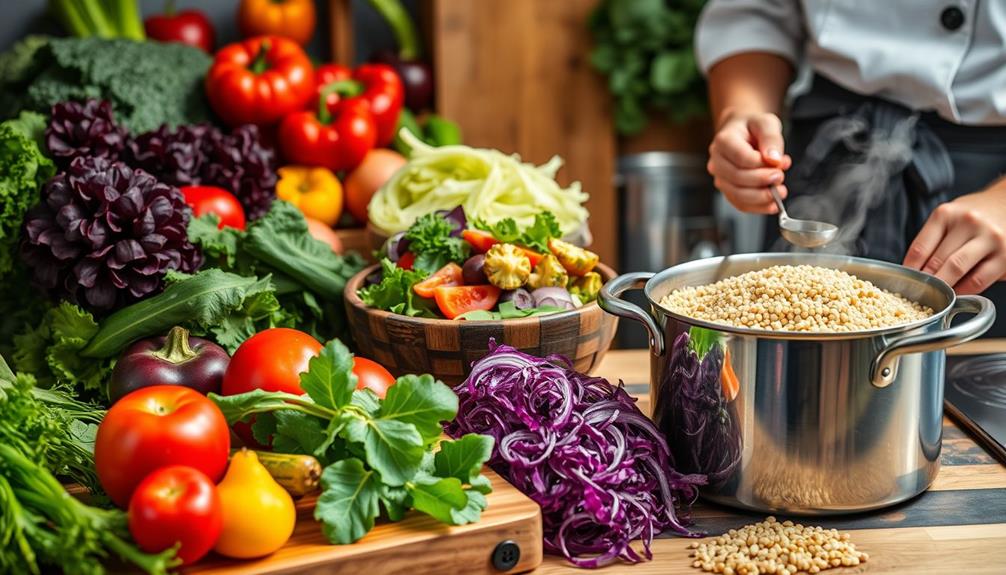
When you cook food, you enhance nutrient absorption, making essential vitamins and minerals more accessible to your body.
Cooking also greatly reduces harmful pathogens, providing a safer eating experience. Certain cooking methods can even increase the availability of beneficial compounds, such as those found in essential oils for health.
Historically, our ancestors thrived on cooked foods, which improved digestibility and contributed to their survival.
Enhanced Nutrient Absorption
Cooking food plays an essential role in enhancing nutrient absorption, making it more beneficial for your health. When you cook certain raw foods, like tomatoes and carrots, you boost the bioavailability of important nutrients such as lycopene and beta-carotene. This means your body can absorb these nutrients more easily, supporting your overall health.
Additionally, understanding breast cancer symptoms can help you maintain better health through informed dietary choices. Historical evidence suggests that early humans gained survival advantages by cooking, as it allowed access to more calories and nutrients from their diets.
Different cooking methods, like steaming and boiling, can break down tough cell walls in vegetables, facilitating greater nutrient release during digestion. Although some vitamins, such as vitamin C and certain B vitamins, may diminish during cooking, the overall health benefits from enhanced nutrient absorption typically outweigh these losses.
Reduced Foodborne Pathogens
One of the most crucial benefits of cooking is its ability to reduce foodborne pathogens. When you cook food at temperatures above 165°F, you effectively kill harmful bacteria and pathogens, markedly lowering the risk of foodborne illnesses like Salmonella and E. coli. This is especially important when dealing with raw foods such as meats and eggs, which are more likely to harbor these dangerous pathogens.
Additionally, cooking can help enhance the overall quality of the food, similar to how regular cleaning and replacing filters in air purifiers can improve air quality.
Cooking isn't just about safety; it also enhances nutrient absorption. By breaking down complex carbohydrates and proteins, cooking makes it easier for your body to digest and absorb essential nutrients. While you might lose some vitamins during the cooking process, the overall health benefits from reducing bacteria far outweigh these losses.
Incorporating cooking into your food preparation routine is a crucial step for food safety. By ensuring your meals are cooked properly, you're not only protecting yourself from potential illnesses but also optimizing the nutritional value of your food.
Historical Survival Advantages
Throughout history, our ancestors discovered that cooking food not only made it tastier but also offered significant survival advantages. By cooking, they increased their caloric intake, supporting the higher energy needs essential for survival. This shift allowed them to enjoy a wider variety of nutrients that raw foods alone couldn't provide, highlighting the importance of diversification strategy in their diets.
Cooking also played a vital role in reducing the risk of foodborne pathogens, which enhanced overall health and lowered mortality rates from foodborne illnesses. As they cooked their meals, they experienced better health outcomes, which contributed to population growth and societal advancement.
Moreover, cooking enhances nutrient bioavailability, enabling the body to absorb more vitamins and minerals effectively. This means that the same ingredients, when cooked, can provide greater nutritional benefits than when consumed raw.
In essence, the practice of cooking not only transformed diets but also shaped human evolution, fostering a healthier, more resilient population. By embracing cooking, our ancestors not only secured their survival but also laid the foundation for the diverse and nutritious diets we enjoy today.
Risks of Raw Food Consumption
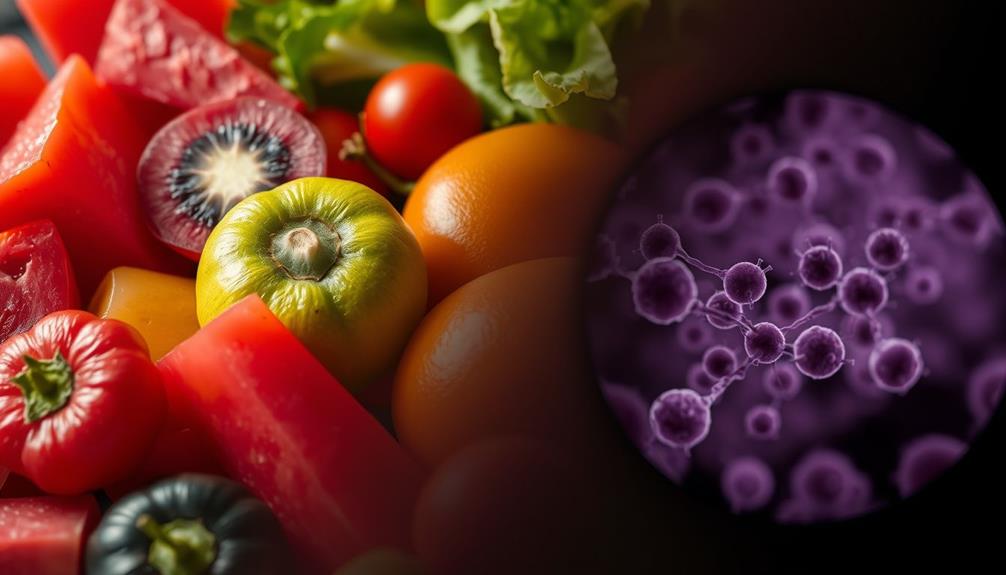
Raw food diets can pose significant health risks that you should be aware of. One major concern is the heightened risk of foodborne illnesses associated with raw foods. Outbreaks linked to raw produce, unpasteurized dairy, and undercooked meats often stem from harmful pathogens like Salmonella and E. coli.
Consuming unpasteurized dairy can lead to severe infections and gastrointestinal issues, so it's important to assess this risk. Additionally, proper diet guidelines suggest that a balanced approach to food can help mitigate these risks. If you're not careful with proper food preparation, you might expose yourself to pesticide residues on raw fruits and vegetables, which can pose health concerns.
Moreover, a limited variety in raw diets can result in nutritional deficiencies, particularly in vital nutrients like protein, vitamin B12, and iron, unless your diet is meticulously planned.
Certain raw foods, like kidney beans and cassava, can be toxic if eaten uncooked, underscoring the significance of proper food preparation techniques.
Types of Foods in Raw Diets
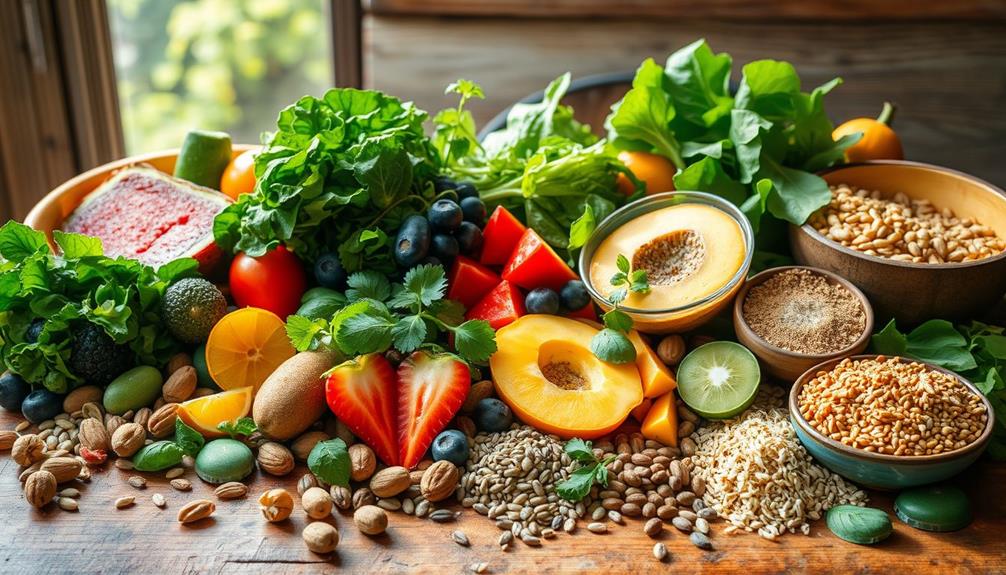
Exploring the variety of foods in raw diets reveals a colorful array of unprocessed fruits and vegetables that are packed with essential vitamins, minerals, and fiber. These raw foods form the foundation of any raw diet, providing a range of flavors and textures to enjoy.
Coffee enthusiasts are encouraged to explore and identify favorites, as this can enhance the overall dietary experience. You'll find staples like nuts and seeds, which offer healthy fats, protein, and crucial nutrients without any cooking involved.
Some raw diets also include dairy products, such as raw cheeses and yogurt, but it's important these are unpasteurized to comply with raw food guidelines. Fermented foods, like kimchee and sauerkraut, play a role too, contributing probiotic benefits and enhancing digestibility. Additionally, incorporating numerous varieties available can add depth and excitement to meals.
While raw fish and meats can be part of some raw diets, they require careful handling due to potential foodborne pathogens, making them a more controversial choice. If you decide to include these, always prioritize safety and sourcing.
In essence, a raw diet encompasses a wide variety of unprocessed foods that can nourish your body while offering exciting culinary experiences. By incorporating fruits, vegetables, nuts, seeds, dairy, fermented foods, and sometimes raw fish or meats, you create a vibrant and nutritious meal plan.
Health Benefits and Nutritional Considerations
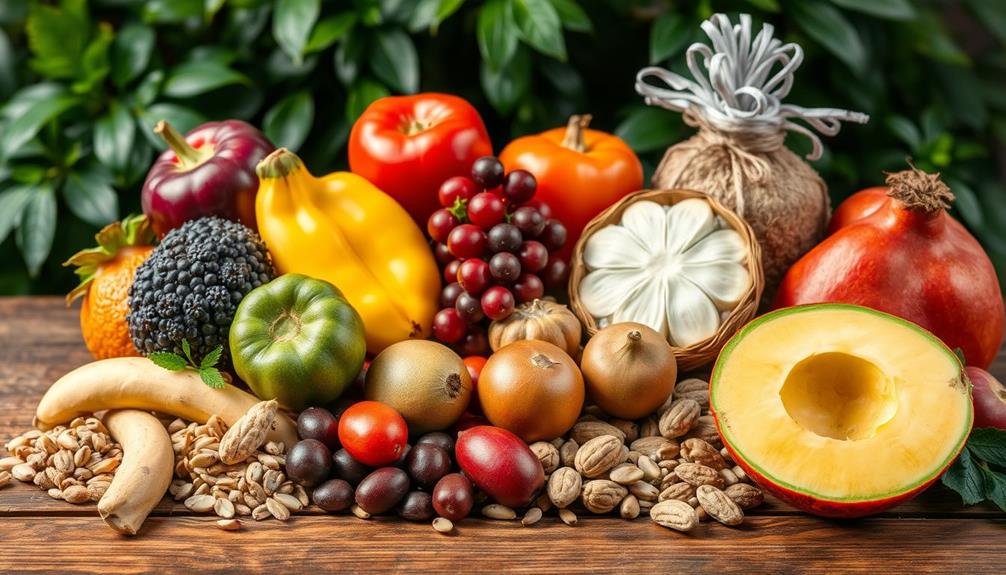
Embracing the raw food diet can lead to a wealth of health benefits, primarily due to its high content of fresh fruits and vegetables. These foods are packed with essential nutrients, vitamins, and minerals that can improve digestion and overall health. You may notice benefits like weight loss, enhanced skin health, and a reduced risk of chronic diseases such as heart disease and diabetes.
However, it's vital to address your nutritional needs while following this diet. A strictly raw food regimen can lead to protein deficiencies and other nutrient gaps if not well-planned. To guarantee you're getting a balanced intake, consider incorporating a variety of foods and possibly supplements for certain vitamins, like B12.
Here's a quick overview of the nutritional considerations:
| Nutrients | Benefits | Considerations |
|---|---|---|
| Vitamins & Minerals | Support overall health and immunity | May require supplementation |
| Protein | Essential for muscle repair and growth | Risk of deficiencies |
| Fiber | Aids digestion and promotes satiety | Can lead to digestive discomfort |
Pros and Cons of Raw Food Diet
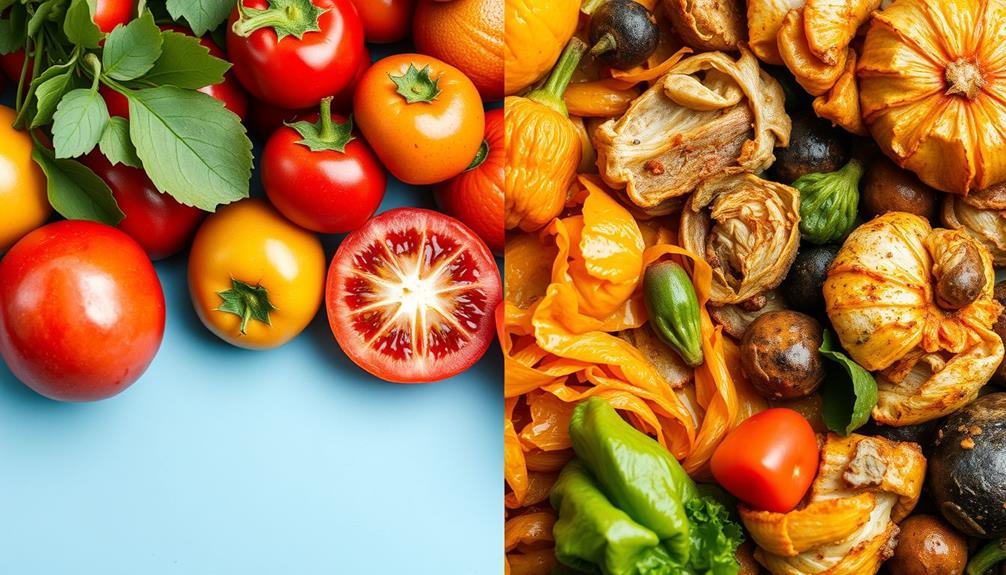
When considering a raw food diet, you'll find notable health benefits like increased nutrient intake from fresh fruits and vegetables, as well as improved digestion due to the high fiber content.
However, it's important to weigh these advantages against potential nutritional risks, such as deficiencies in protein and vitamin B12.
Additionally, incorporating raw foods like herbal teas may complement your diet by providing relaxation and digestive support.
Balancing these factors will help you determine if this diet fits your lifestyle and health goals.
Health Benefits Overview
The raw food diet offers a mix of significant health benefits and potential drawbacks that you should consider. One of the primary advantages is that it's rich in raw fruits and vegetables, providing high levels of nutrients and fiber that can enhance digestion and overall health.
This approach to eating can also tap into the power of imagination by encouraging individuals to explore new food experiences and develop creative meal ideas. You may experience weight loss due to the lower calorie intake associated with unprocessed foods, which can lead to reduced body fat and lower triglyceride levels.
Additionally, the health benefits of the raw food diet include improved skin health, increased energy, and a reduced risk of chronic diseases like heart disease and diabetes.
However, it's important to be aware of the potential risks. The diet can lead to nutrient deficiencies, particularly in protein and vitamin B12, which are challenging to obtain from raw sources alone.
Moreover, the high fiber content may cause digestive issues for some individuals. Finally, the risk of foodborne illnesses is heightened since consuming raw produce, dairy, and meats exposes you to harmful bacteria like Salmonella and E. coli.
Balancing these aspects is vital for anyone considering the raw food diet.
Nutritional Risks Considerations
Considering the health benefits of the raw food diet, it's important to weigh the potential nutritional risks that come with it. While you may enjoy a diet rich in fresh fruits and vegetables, you could face deficiencies in essential nutrients like protein and vitamin B12 due to limited food variety. Cooking can enhance the bioavailability of certain nutrients, such as beta-carotene and lycopene, that your body may not absorb as effectively from raw foods.
In addition, following a raw food diet may lead to reduced caloric intake. This could result in weight loss, but also risks energy deficiency and nutrient imbalances if you don't plan your meals carefully. Moreover, the risk of foodborne illnesses, such as Salmonella and E. coli, rises with the consumption of raw foods, particularly unpasteurized items.
Lastly, long-term adherence may cause digestive issues and health risks, like lower bone mass and elevated homocysteine levels.
| Nutritional Risks | Potential Issues | Considerations |
|---|---|---|
| Nutrient Imbalances | Deficiencies in protein, B12 | Meal planning is essential |
| Foodborne Illnesses | Increased risk with raw foods | Sourcing and handling matter |
| Digestive Issues | Long-term complications | Monitor health regularly |
Challenges of Following Raw Diet

Following a raw food diet can be socially challenging, especially since limited food options often make dining out or attending gatherings difficult. You might find yourself facing some of these hurdles:
- Limited choices at restaurants and social events
- Time-consuming meal preparation and planning
- Potential digestive discomfort as your body adjusts
- Risks of nutrient deficiencies without careful planning
Preparing raw meals isn't just about choosing fresh fruits and vegetables; it often demands advanced kitchen skills and knowledge of food safety.
If you don't plan your meals thoroughly, you could end up wasting food since raw ingredients spoil faster than cooked ones.
Plus, the initial shift to a high-fiber diet may lead to gas and cramping, which can be uncomfortable.
Long-term adherence to a raw food diet may also expose you to deficiencies in essential nutrients like protein, vitamin B12, and iron.
This means you'll need to be especially diligent in your meal planning and may even need to contemplate supplementation to maintain a balanced diet.
Food Preparation Techniques
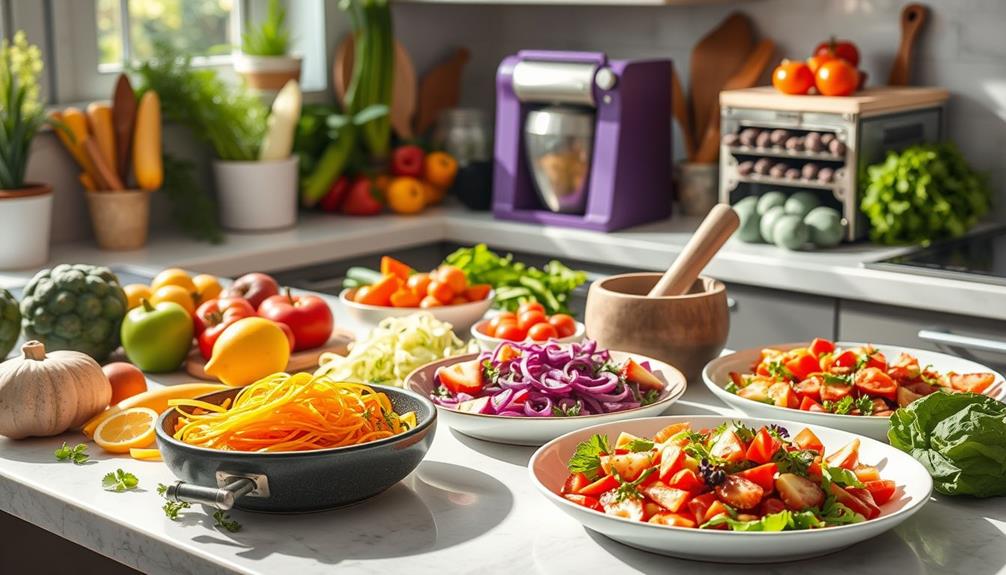
Exploring various food preparation techniques is essential for anyone on a raw food diet, as these methods enhance digestibility and nutrient absorption. Here's a quick overview of some effective techniques:
| Technique | Description |
|---|---|
| Soaking | Soak beans and grains in water to break down anti-nutrients, improving digestibility. |
| Sprouting | Sprout grains and seeds to increase nutrient density and reduce anti-nutritional factors. |
| Dehydrating | Dehydrate fruits and vegetables at low temperatures to preserve nutrients and extend shelf life. |
| Juicing/Blending | Juice or blend fresh produce for easy consumption of a variety of nutrients. |
Frequently Asked Questions
What Is the Overview of Raw Food Diet?
The raw food diet focuses on unprocessed, whole foods, emphasizing fruits, vegetables, nuts, and seeds. You'll enjoy benefits like increased energy and improved digestion, but you'll need to plan carefully to avoid nutritional deficiencies.
What Is Raw Food Explanation?
Imagine biting into a crisp apple, bursting with flavor. Raw food means eating uncooked, unprocessed fruits, vegetables, and nuts. It's all about preserving nutrients and enzymes for potential health benefits while enjoying vibrant, natural tastes.
What Is Considered Raw Food?
When you think about raw food, consider uncooked fruits, vegetables, nuts, and seeds. You're also looking at unprocessed dairy and some animal products, all prepared without heat to preserve nutrients and enzymes.
What Is the Raw Food Theory?
The raw food theory suggests that eating uncooked foods preserves essential nutrients and enzymes. You'll likely experience increased energy, better digestion, and reduced chronic disease risks by choosing raw fruits, vegetables, nuts, and seeds.
Conclusion
In your quest for a cleaner, greener diet, embracing raw foods can be a invigorating route. With vibrant veggies and luscious fruits, you can savor the sensational flavors nature offers. However, stay savvy about potential pitfalls and make sure you're well-informed. As you navigate the raw food domain, remember that balance is key. By blending the best of both worlds—raw and cooked—you can cultivate a colorful, healthful plate that truly nourishes your body and spirit.

